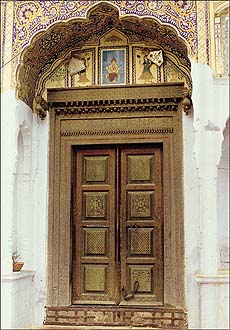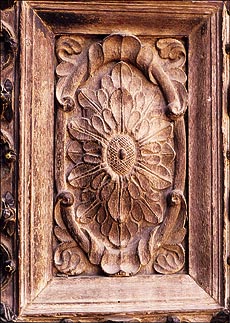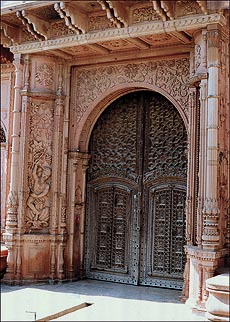 The engraved door art form in
Haryana is both variable and wide-spread and its
excellent holistic composition is comparable to art forms
available in other regions of the Indian subcontinent, says Ranbir
Singh The engraved door art form in
Haryana is both variable and wide-spread and its
excellent holistic composition is comparable to art forms
available in other regions of the Indian subcontinent, says Ranbir
Singh
A
magnificent legacy
ENGRAVED images of Ganapati,
Saraswati, Lakshmi and a few other Hindu gods and
goddesses can be found on artistically produced doors of havelis
in Haryana.
The icons of Ganapati,
Saraswati, Lakshmi, Shiva, Hanuman and Krishna can be
seen on wooden gate structures of several magnificent
village havelis. Our traditional havelis used
to be extensively decorated in all probable ways and the
front view was amazingly inviting. Artists of various
hues and disciplines jointly thought of native art forms
and the sentiments of both the haveli owner as
well as the craft persons have been excellently expressed
in the artistic engravings on wooden door frames and door
panels. A large number of door structures, routinely made
of excellent shalva or sheesam reveal that
the overhead plank —a sirdar — was the
most appropriate site for an engraved depiction of the
Hindu deities. In the process of creation, the central
spot was invariably allotted to the benevolent Ganapati
flanked by his female spiritual companions —
Riddhi and Siddhi, Lord Ganesha’s two wives, but
otherwise personal attendants.
The presence of Lord
Ganapati’s figure at the marked place is considered
sacred and is believed to bring peace and prosperity to
the occupants of the house.
The icons of Ganapati are
generally placed on an overhead thick oblong and square
shaped plank of a wooden gate structure or on the topmost
panel. The deity is mostly found in a squatting posture,
and, sometimes, in a dancing form, too, while Riddhi and
Siddhi stand beside him in an attractive posture, waving
the chanvaras. Lord Ganesha’s four-armed
figure is invariably engraved on the front side of havelis.
Wood carving and engraving
as an art form has flourished in Haryana since time
immemorial. The trading community patronised it. Ancient
texts Astadhayayi and Brihatsam-ghita carry
detailed information not only on the selection of
appropriate wood but also on designing household
utilities, pillars, posts and door structures. Save in
the arid and semi-arid zones of Bhiwani and Hisar
districts, engraved art work on wood cannot survive for
long elsewhere in Haryana because of the corrosive
weather conditions and the damage caused by insects.
The engraved door art form
in Haryana is both variable and widespread and its
excellent holistic composition is comparable to art forms
available in other regions of the Indian subcontinent,
especially Kashmir, upper Himachal Pradesh, the
Shekhawati region and Jaisalmer in Rajasthan, Gujarat
(Kutchh region) and Andhra Pradesh. The design of door
panels depended more on imitation than on contiguity. Except
in the northern districts of erstwhile Ambala and modern
Sirsa, at least 5,000 sites (at 500 locations) can be
identified. This, after a decade-and-a-half of research
on traditional wood-based architecture and engraving
practices that were prevalent until the middle of this
century, but are almost defunct now. Prosperous and
traditional settlements in Hisar, Bhiwani, and Ladwa can
still astound us with impressive doors made of good
quality wood. Their rich patterns, both geometrical and
floral, expertise of the craft persons, selection of
materials, and the grandeur of the finished product is
very impressive. These finely engraved objects also
existed in the ancient settlements in peninsular Arabia
and many fine specimens of doors can be seen in Egypt
too. Except
in the northern districts of erstwhile Ambala and modern
Sirsa, at least 5,000 sites (at 500 locations) can be
identified. This, after a decade-and-a-half of research
on traditional wood-based architecture and engraving
practices that were prevalent until the middle of this
century, but are almost defunct now. Prosperous and
traditional settlements in Hisar, Bhiwani, and Ladwa can
still astound us with impressive doors made of good
quality wood. Their rich patterns, both geometrical and
floral, expertise of the craft persons, selection of
materials, and the grandeur of the finished product is
very impressive. These finely engraved objects also
existed in the ancient settlements in peninsular Arabia
and many fine specimens of doors can be seen in Egypt
too.
In spite of the weathering
effect, many gate structures made of wood and wooden door
panels with intricate engravings still retain the fine
textural finish and sharpness of design that we rarely
come across nowadays in Haryana.
Wood craft in Haryana is
intricate and knowledge based.
By the techniques of
denting, rubbing, forging, placing and fixing, artisans
were able to fill ‘space’ with a rich form and
style. Almost all door panels had hinges called chool
and maruaa. The base or the rear support of these
artistic door panels was made of two to three inches
thick sheesham planks. On the front plane, all art
work was affixed so that it could be visible even while
the door was shut.
Local artisans also
thought of giving appropriate names to various forms of
artistically created door panels like, pachbeenee,
satbeenee, naubeenee, aterna, athmashaa phool and Gujarati.
The prefixes pach and sat mean five and
seven, respectively, and so on. It was difficult to make
door panels beyond naubeenee as it marred the
aesthetic quality. The beenee here denotes the
vertical bars holding the embossed design on a door
panel.
There are scores of
variations in style in both the Gujarati and the aterna
forms. While the Gujarati forms of panels drew
inspiration from a horde of indigenous flowers and
required delicate workmanship during creation, the aterna
forms were like a puzzle layout, which could have
emanated from the famous chakravayuh in the Mahabharata.
In Haryana, the art of
creating beautiful door panels evolved gradually and
became popular and famous in 1930s in Bhiwani town, a
bustling trading centre between Gujarat, adjoining
Rajpootana and Delhi. As patrons became readily
available, wood craftsmen flocked to Bhiwani from
neighbouring villages and even the Shekhawati region of
Rajpootana.
Among these, Ganeshi and
Johri earned reputation. Ganeshi was indeed a master
craftsman who was active till the early 1960s. A few
masterpiece door panels created by him, and still
existing, can fetch at least Rs 10 lakh.
Business persons involved
in trading of antique doors in Haryana have taken away
many pieces of valuable art work. During the couple of
years, organised activity in acquiring and disposing of
door structures with valuable artwork has come to light.
In the absence of a
relevant law for protection of objects with a heritage
value (those that are not covered under the Protection of
Monuments Act, 1952, Haryana’s numerous villages are
gradually losing cultural property and visual character. 
Creation of duplicate door
structures at workshops run by businessmen for local sale
as well as export of handicrafts is a cause for concern.
The rapid growth of the demand for ancient doors as
traditional art objects in big cities has led to the
mushroom growth of persons dealing in antiques. It is
hard for customers to distinguish between a genuine or a
spurious antique, and thus, the trade flourishes
In this emerging scenario
will the new class of wood artists ever be able to create
new door forms, though classical techniques, to suit
architectural and aesthetic tastes as well as needs of
future builders? Will they continue to thrive on
plagiarising traditional glory?
Modern schools of wood
craft should seriously think about this problem and
contribute towards the conservation of wood art relating
to door structures of traditional havelis in
Haryana.

|

